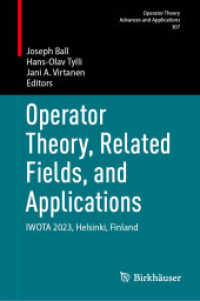- ホーム
- > 洋書
- > 英文書
- > Science / Mathematics
Full Description
A First Step toward a Unified Theory of Richly Parameterized Linear Models
Using mixed linear models to analyze data often leads to results that are mysterious, inconvenient, or wrong. Further compounding the problem, statisticians lack a cohesive resource to acquire a systematic, theory-based understanding of models with random effects.
Richly Parameterized Linear Models: Additive, Time Series, and Spatial Models Using Random Effects takes a first step in developing a full theory of richly parameterized models, which would allow statisticians to better understand their analysis results. The author examines what is known and unknown about mixed linear models and identifies research opportunities.
The first two parts of the book cover an existing syntax for unifying models with random effects. The text explains how richly parameterized models can be expressed as mixed linear models and analyzed using conventional and Bayesian methods.
In the last two parts, the author discusses oddities that can arise when analyzing data using these models. He presents ways to detect problems and, when possible, shows how to mitigate or avoid them. The book adapts ideas from linear model theory and then goes beyond that theory by examining the information in the data about the mixed linear model's covariance matrices.
Each chapter ends with two sets of exercises. Conventional problems encourage readers to practice with the algebraic methods and open questions motivate readers to research further. Supporting materials, including datasets for most of the examples analyzed, are available on the author's website.
Contents
Mixed Linear Models: Syntax, Theory, and Methods: An Opinionated Survey of Methods for Mixed Linear Models. Two More Tools: Alternative Formulation, Measures of Complexity. Richly Parameterized Models as Mixed Linear Models: Penalized Splines as Mixed Linear Models. Additive Models and Models with Interactions. Spatial Models as Mixed Linear Models. Time-Series Models as Mixed Linear Models. Two Other Syntaxes for Richly Parameterized Models. From Linear Models to Richly Parameterized Models: Mean Structure: Adapting Diagnostics from Linear Models. Puzzles from Analyzing Real Datasets. A Random Effect Competing with a Fixed Effect. Differential Shrinkage. Competition between Random Effects. Random Effects Old and New. Beyond Linear Models: Variance Structure: Mysterious, Inconvenient, or Wrong Results from Real Datasets. Re-Expressing the Restricted Likelihood: Two-Variance Models. Exploring the Restricted Likelihood for Two-Variance Models. Extending the Re-Expressed Restricted Likelihood. Zero Variance Estimates. Multiple Maxima in the Restricted Likelihood and Posterior.







